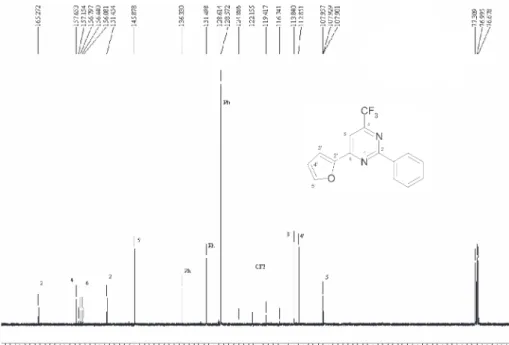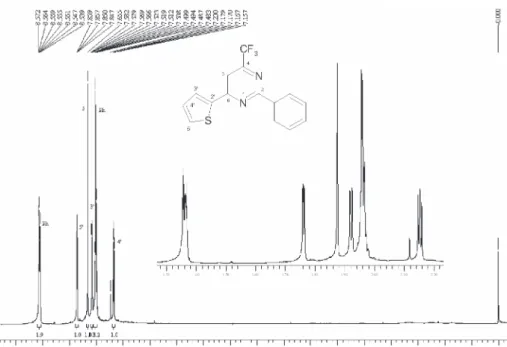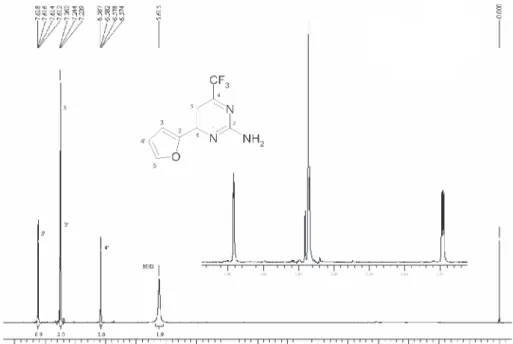J. Braz. Chem. Soc., Vol. 18, No. 7, 1316-1321, 2007. Printed in Brazil - ©2007 Sociedade Brasileira de Química 0103 - 5053 $6.00+0.00
ArticleArticleArticleArticleArticle
*e-mail: alexflores@smail.ufsm.br
Synthesis of 6-(2-Furyl) and 6-(2-Thienyl)-4-trifluoromethylpyrimidinones and pyrimidines
from 4-(2-Heteroaryl)-4-methoxy-1,1,1-trifluoro-3-buten-2-ones
Alex F. C. Flores,* Lucas Pizzuti, Sergio Brondani, Marcelo Rossato, Nilo Zanatta and Marcos A. P. Martins
Departamento de Química, Universidade Federal de Santa Maria, 97105-900 Santa Maria-RS, Brazil
Neste trabalho é apresentada a síntese, em rendimentos razoáveis (50-67%), de novos sistemas biheterocíclicos, duas 6-(2-heteroaril)-4-trifluormetil-2-(1H)-pirimidinonas (2a,b) e uma série de dez 6-(2-heteroaril)-4-trifluormetilpirimidinas (3a,b - 7a,b) a partir da ciclocondensação de 1,1,1-trifluor-4-(2-heteroaril)-4-metoxi-3-buten-2-onas com uréia e amidinas. As estruturas de todos os compostos foram atribuídas pelos dados de análise elementar, espectrometria de massas e dados de RMN 1H e 13C. Os dados de RMN 1H e 13C são mostrados de maneira sistemática.
Também apresentamos os dados de difração de raios-X de um monocristal da 2-amino-6-(tien-2-il)-4-trifluormetilpirimidina (5b).
The synthesis of biheterocyclic systems 6-(2-furyl)-pyrimidines and 6-(2-thienyl)-pyrimidines in reasonable yields (50-67%), two 6-(2-heteroaryl)-4-trifluoromethyl-2-(1H )-pyrimidinones (2a,b) and a series of ten 6-(2-heteroaryl)-4-trifluoromethylpyrimidines (3a,b
-7a,b) from the cyclocondensation of 1,1,1-trifluoro-4-(2-heteroaryl)-4-methoxy-3-buten-2-ones with urea and amidines is reported. Structures of all compounds have been elucidated by elemental analysis, mass spectrometry and 1H, 13C NMR measurements. The 1H and 13C NMR data are
systematically reported. The X-ray diffraction data for monocrystal from 2-amino-4-trifluoromethyl-6-(thien-2-yl)-pyrimidine (5b) are reported.
Keywords: 4-trifluoromethylpyrimidines, 1,1,1-trifluoro-4-methoxy-3-buten-2-ones, [3 + 3] cyclocondensation
Introduction
Interest in perfluoroalkylated heterocyclic compounds is largely due to the fact that they have enhanced biological activity and can be used as medicinal or agricultural
chemicals.1-8 Among them, fluorinated pyrimidines have
been shown to possess high biological activities as bactericides, fungicides, analgesics, antipyretics and
anti-inflammatories.9-15
Perfluoroalkylated N-containing heterocycles can be obtained by various methods, including the widely used reactions of 1,3-dicarbonyl compounds with bi-nucleophiles. For example, the cyclization of N-C-N blocks (urea, guanidines and amidines) with perfluoroalkyl containing bielectrophiles (diketones,
1,3-ketoesters, 1,3-ketoamides, α,β-enones) is considered the
main procedure for the synthesis of perfluoroalkyl
substituted pyrimidine derivatives.15-18
Derivatives 2-substituted of the 6-(2-furyl)-4-trifluoromethylpyrimidines and 6-(2-thienyl)-4-trifluoromethylpyrimidines were early synthesized by cyclocondensation respectively of 1-(2-furyl)-4,4,4-trifluorobutane-1,3-dione or
1-(2-thienyl)-4-trifluoro-butane-1,3-dione with amidines NH2C(NH)X [ X = OR,
NH2, SMe], however only few analytical data were
reported.19-23 The patent reports show only melting point
as accessible analytical data for these compounds. The 6-furyl and 6-thienyl derivatives of 2-amino-4-trifluoromethylpyrimidine and 2-hydroxy (or 2-mercapto)-4-trifluoromethylpyrimidine obtained from cyclocon-densation of 1-(2-heteroaryl)-4,4,4-trifluorobutane-1,3-dione and guanidine or urea were applied in effective treatment of
cardiorenal disease and in edema.19 Moreover had
demonstrated eficient inhibitory activity in mevalonic acid
incorporation during biosynthesis of cholesterol.20
1317 Flores et al.
Vol. 18, No. 7, 2007
biheterocyclic systems.9,24,25 The present work aimed to report
efficient procedures for the systematic cyclocondensation of
4-(2-furyl)-4-methoxy-1,1,1-trifluoro-3-buten-2-one (1a) and
4-methoxy-4-(2-thienyl)-1,1,1-trifluoro-3-buten-2-one (1b)
with urea, acetamidine, benzamidine, guanidine,
2-methyl-2-pseudothiourea and 1H-pyrazole-1-carboxyamidine for
synthesis of the series of biheterocyclic
6-(2-heteroaryl)-4-trifluoromethylpyrimidinones 2 and
6-(2-heteroaryl)-4-trifluoromethylpyrimidines 3-5, 7 and new three ring system
2-(pyrazol-1-yl)-4-trifluoromethyl-6-(2-heteroaryl)pyrimidines
6.
Results and Discussion
The
4-(2-heteroaryl)-4-methoxy-1,1,1-trifluoromethyl-3-buten-2-ones 1a and 1b were prepared using the
previously reported procedure.25 The
6-(2-furyl)-4-trifluoromethyl-1H-pyrimidin-2-one 2a and the
6-(2-thienyl)-4-trifluoromethyl-1H-pyrimidin-2-one 2b were
prepared in very low yields (< 10%) from the reaction of
1a or 1b with ureain reflux EtOH or, even i-PrOH (Scheme
1).12 Several attempts to improve the yields by refluxing 1a
or 1b with urea for long periods (2 days) without catalysis
were unsuccessful. However, polymeric material was obtained in reactions in MeOH with Brönsted HCl catalysis
at room temperature or with Lewis acid BF3•OEt
2 or
Ti(O-iPr)4 catalysis at reflux temperature (>65 °C) for long
periods.15 Our experiments have demostrated that the best
medium was anhydrous i-PrOH with drops of BF3•OEt
2 at
50 °C during 20 h, furnishing reasonable yields (50%) for
2a and 2b.12 The 1H NMR spectra have show a single set of
signals (see, Experimental) indicating that compounds 2a
and 2b exist as one of the possible tautomers. The
2(1H)pyrimidin-2-one structure was confirmed by
characteristic signal from N-H at 12.93-12.95 ppm. In the search for the optimum cyclocondensations
condition for 1a, 1b andamidines acetamidine hydrochloride
was used as a model amidine. The cyclocondensations in
MeOH or iPrOH under Brönsted HCl or Lewis BF3•OEt
2
catalysis were unsuccessful, the reactants were recovered. In contrast to the synthesis of 4-polyfluoroalkylpyrimidines
by condensation in refluxing iPrOH under Lewis BF3•OEt
2
catalysis for 4 to 26 h,12 we have obtained products
6-(2-heteroaryl)-2-methyl-4-trifluoromethyl-pyrimidines 3a and
3b in good yields using alkaline medium, reacting
acetamidine hydrochloride with a 1 mol L-1 KOH aqueous
solution and adding to MeOH solution of 1a or 1b at room
temperature. TLC analyses during reaction period have revealed that the 1,3-dielectrophiles were consumed after 1
hour, furnishing good yields of the pyrimidines 3. The
6-(2-heteroaryl)-2-phenyl-4-trifluoromethyl-pyrimidines 4a, 4b,
2-amino-6-(2-heteroaryl)-4-trifluormethyl-pyrimidines 5a,
5b, 6-(2-heteroaryl)-2-(1H
-pyrazol-1-yl)-4-trifluoro-methylpyrimidines 6a, 6b and the
6-(2-heteroaryl)-2-thiomethyl-4-trifluoromethyl-pyrimidines 7a, 7b were
obtained in similar alkaline medium with the procedure described above. The structure of all compounds was
determined from 1H, 13C and mass spectrometry. Based on
our previous reports on the chemistry of
6-aryl-4-trifluoromethyl-1H-pyrimidin-2-ones and
6-aryl-4-trifluoromethyl-pyrimidines derived from 4-aryl-4-methoxy-1,1,1-trifluoro-3-buten-2-ones, the assignment of each signal
in the 13C NMR spectra of compounds 2-7 was accurately
established.15,16
Scheme 1. [3 + 3]cyclocondensations.
N N Y CF3 O H N N Y CF3 R O Y OMe CF3 N N
2a b,
3 7a b- , 1a b, NH2C(R)NH.HX
NaOH 1 mol L , MeOH-1
rt-50 °C, 1 h
50-67% (NH2)2C=O
Et2O BF. 3,i-PrOH 45-50 °C, 20 h
48-52%
X = Cl or HSO4
Y O S
a b
R
3a b, 4a b, 5a b, 6a b, 7a b,
1318 Synthesis of 6-(2-Furyl) and 6-(2-Thienyl)-4-trifluoromethylpyrimidinones J. Braz. Chem. Soc.
The 1H and 13C spectra of products showed set of signals
attributed to aromatic pyrimidines 3a, 3b to 7a, 7b. The
structure of compound
2-amino-6-(2-thienyl)-4-trifluoromethyl-pyrimidine 5b was established by X-ray
diffraction analysis. The overall view of the molecule is shown in Figure 1. The 6-(2-thienyl)-pyrimidine system is virtually coplanar (the mean deviation of the atoms from the plane is 0.008 Å). The thienyl ring suffers a rotational disorder, atoms S1 and C7 were modeled as exchanged with a minor occupancy fraction refined to 19.6%. The
trifluoromethyl group presents a rotational disorder; the three F atoms were refined in a position rotated approximately 45º from their original positions at 5.3%
occupancy. Crystal data for 5b are shown in Table 1.
Conclusions
In conclusion, the biheterocyclic systems 6-(2-furyl)-and 6-(2-thienyl)-pyrimidinones 6-(2-furyl)-and 6-(2-furyl)- 6-(2-furyl)-and 6-(2-thienyl)-pyrimidines were efficiently obtained by reacting 4-(2-heteroaryl)-4-methoxy-1,1,1-trifluoro-3-buten-2-ones with N-C-N binucleophiles, in reasonable to good yields (50-67%). The best reactional medium for
urea cyclocondensation was under BF3•OEt
2 Lewis acid
catalysis. However the cyclocondensations with hydrochoride amidines occurred only in alkaline media with NaOH, pH >15, furnishing good yields of 6-(2-heteroaryl)-pyrimidines.The tricyclic systems 6-(2-furyl)-and 6-(2-thienyl)-2-(1-pyrazolyl)-pyrimidines are new.
Experimental
The synthesis of
4-(2-heteroaryl)-4-methoxy-1,1,1-trifluoro-3-buten-2-one, 1 has been reported elsewhere.20
Urea, amidines and BF3•OEt
2 were used as obtained from
commercial suppliers. MeOH and i-PrOH were purified
before using. 1 mol L-1 solution of NaOH was prepared
by the dissolution of 0.40 g of NaOH in 100 mL of distilled water. Yields listed in Table 2 are of isolated compounds. All melting points were determined on a Reichert Thermovar apparatus and are uncorrected. The
1H and 13C spectra were recorded at 298 K on a Bruker
DPX 400 spectrometer (1H at 400.13 MHz, 13C at 100.63
MHz) with digital resolution of ± 0.01 ppm. All the
chemical shifts are expressed in ppm, 1H and 13C are
reported with respect to internal TMS. 0.1 mol L-1 CDCl
3
solutions were used except with compounds 2, 0.1 mol
L-1 in DMSO-d
6. H-H and C-F coupling constants are in
Hz. Mass spectra were registered in a HP 5973 MSD connected to a HP 6890 GC and interfaced by a Pentium PC. The GC was equipped with a split-splitless injector, auto-sampler, cross-linked HP-5 capillary column (30 m, 0.32 mm of internal diameter), and helium was used as the carrier. Elemental analyses were performed on a Perkin-Elmer 2400 CHN elemental analyzer (São Paulo University-São Paulo, Brazil). The crystal and molecular
structure of 5b was determined by a single crystal X-ray
diffraction study. Data were recorded on a Bruker Kappa Apex II CCD area detector with graphite monochromatized Mo Ka radiation (l 0.71073 Å). The data were processed with SAINT and SADABS. The
Table 1. Crystal dataa and structure refinement for 2-amino-4-trifluoromethyl-6-(2-thienyl)-pirimidine (5b)
Crystal data
Formula C9H6F3N3S
Habit Colorless prisms
Size / (mm) 0.240 x 0.090 x 0.079 Symmetry Monoclinic, P21/c Unitcelldimensions / (Å, °) a = 5.0982(2) α = 90
b = 19.4858(7) β = 95.779(2) c = 10.1807(3) γ = 90 Volume / (Å3), Z 1006.24(6), 4
Dc / (g cm-3), F(000) 1.619, 496
µ / (mm-1) 0.339
θ range for data collection / (º) 3.73 to 28.37 Index ranges -6≤h≤6,
-26≤k≤26, -13≤l≤13 Reflections collected 11012 Independent reflections (R-int) 2501 (0.0426) Completeness to θ 99.4 %
Tmin-Tmax 0.7957-1.0
Solution Direct methods SHELXS-97 Refinement method Full matrix least-squares on F2
Data / restraints / parameters 2501 / 0 / 146 Goodness-of-fit on F2 0.947
Final R indices [I > 2σ(I)] R1 = 0.0434, wR2 = 0.1209 R indices, all data R1 = 0.0790, wR2 = 0.1389 Largest diff. peak and hole / (e. Å3) 0.202 and -0.282
aCCDC 286548 contains the supplementary crystallographic data for this
pa-per. These data can be made available free of charge via www.ccdc.cam.ac.uk/ data_request/cif, by emailing data_request@ccdc.cam.ac.uk or by contacting CCDC.
1319 Flores et al.
Vol. 18, No. 7, 2007
structure was solved by direct methods (SHELXS-97)26
and additional atoms were located in the difference
Fourier map and refined on F2 using the SHELXTL and
Wingx packages.27
6-(2-Furyl)[(2-thienyl)]-4-trifluoromethylpyrimidin-2-one (2a, b). General Procedure
Compounds 1a (3 mmol, 0.67 g) or 1b (3 mmol, 0.71
g) and urea (3.3 mmol, 0.21 g) were dissolved in 3 mL of
anhydrous i-PrOH. Then, 3 drops of BF3•Et
2Owere added
and the mixture was stirred at 50 °C for 20 h. The solvent was partially evaporated and the product crystallized by cooling. The solid was filtered, washed with cold water
and recrystallized from MeOH to give 2a and 2b,
respectively.
6-(2-Furyl)-4-trifluoromethyl-1H-pyrimidin-2-one, 2a
Yield 48 %; mp 282-284 ºC; 1H NMR (400 MHz,
DMSO-d6): δ 6.82 (dd, 1H, J 3.5, J 1.66, H4’), 7.48 (s,
1H, H5), 7.67 (d, 1H, J 3.5,H3’), 8.07 (d, 1H, J 1.66,
H5’), 12.93 (s, 1H, NH); 13C NMR (100 MHz,
DMSO-d6): δ 163.1, 157.9 (2J
CF35), 157.0, 148.5, 147.6, 120.2
(JCF277), 115.8, 112.9, 100.6; MS (70 eV) m/z 230 (M+,
100), 118 (16), 90 (11), 63 (18). Anal. Calc. for
C-9H5F3N2O2: C, 46.97; H, 2.19; N, 12.17. Found: C,
46.87; H, 2.18; N, 12.05.
6-(2-Thienyl)-4-trifluoromethyl-1H-pyrimidin-2-one, 2b
Yield 52 %; mp 266-268 ºC; 1H NMR (400 MHz,
DMSO-d6): 7.24 (dd, 1H, J 4.8, J 3.4, H4’); 7.89 (d, 1H,
J 4.8, H3’); 7.95 (s, 1H, H5); 8.24 (d, 1H, J 3.4, H5’);
12.95 (s, 1H, NH); 13C NMR (100 MHz, DMSO-d6):
δ 165.1, 163.5, 156.6 (2J
CF35), 140.4, 132.6, 130.9, 128.7,
120.2 (JCF274), 103.5; MS (70 eV) m/z 246 (M+, 100),
227 (10), 134 (30), 69 (17). Anal. Calc. for C-9H5F3N2SO:
C, 43.91; H, 2.05; N, 11.38. Found: C, 43.59; H, 2.02; N, 11.23.
6-(2-Furyl)[(2-thienyl)]-4-trifluoromethylpyrimidines (3
-7a, b). General Procedure
Acetamidine hydrochloride (3 mmol) was added to
an aqueous KOH 1 mol L-1 solution (3 mL). The resulting
solution was added to a MeOH solution of compounds
1a (3 mmol, 0.66 g) or 1b (3 mmol, 0.71 g). The resulting
mixture was stirred at room temperature at 50 °C for 1 h. Then MeOH was evaporated and the resulting material
was diluted with CHCl3 (50 mL) and washed with water
(3 × 20 mL). The organic solution was dried over
anhydrous MgSO4 and the solvent was removed, the solid
products were recrystallized from hexane, furnishing the
pure crystalline products 3a, 3b, 5a, 5b, 6a and 6d. The
compounds 7a and 7b were oils purified by
chro-matography column with hexane:chloroform (1:1) as eluent. When the precipitated product was formed, it
was filtered, washed with water and dried over CaCl2.
The products 4a, 4b were obtained pure (GC-MS, 1H
NMR).
6-(2-Furyl)-2-methyl-4-trifluoromethylpyrimidine, 3a
Yield48 % (71 %, ref. 28); mp 41-43 ºC; 1H NMR
(400 MHz, CDCl3): 2.82 (s, 3H, Me); 6.62 (dd, 1H, J
3.52 Hz, J 1.76 Hz, H4’); 7.38 (d, 1H, J 3.52 Hz, H3’);
7.65 (d, 1H, J 1.76 Hz, H5’); 7.72 (s, H5); 13C NMR
(100 MHz, CDCl3): δ 169.4, 157.4, 156.1 (2J
CF35 Hz),
151.0, 145.8, 120.2 (JCF274), 113.9, 112.8, 107.5 (4J
CF
2.8 Hz), 25.9; (MS (70 eV) m/z 228 (M+, 95), 209 (27),
118 (100), 90 (48), 63 (78). Anal. Calc. for C10H7F3N2O:
C, 52.64; H, 3.09; N, 12.28. Found: C, 52.82; H, 3.36; N, 12.38.
2-Methyl-6-(2-thienyl)-4-trifluoromethylpyrimidine, 3b
Yield 53 %; mp 47-49 ºC; 1H NMR (400 MHz,
CDCl3): 2.81 (s, 3H, Me); 7.18 (dd, 1H, J 5.01, J 3.79
Hz, H4’); 7.59 (dd, 1H, J 5.01 Hz, J 1.04 Hz, H3’); 7.65
(s,1H, H5); 7.84 (dd, 1H, J 3.79 Hz, J 1.04 Hz, H5’); 13C
NMR (100 MHz, CDCl3): δ 169.6, 161.1, 155.9 (2J
CF35
Hz), 141.3, 131.5, 128.7, 128.6, 120.2 (JCF273 Hz), 107.8
(4J
CF2.8 Hz), 25.9; MS (70 eV) m/z 244 (M
+, 100), 225
(13), 134 (72), 69 (21). Anal. Calc. for C10H7F3N2S: C,
49.18; H, 2.89; N, 11.47. Found: C, 48.78; H, 2.91; N, 11.41.
6-(2-Furyl)- 2-phenyl-4-trifluoromethylpyrimidine, 4a
Yield61 % (69 %, ref. 29); mp 66-68 ºC; 1H NMR
(400 MHz, CDCl3): 7.46-7.51 (m, 3H, Ph); 7.47 (d, 1H,
J 3.3 Hz, H3’); 7.57 (dd, 1H, J 3.3 Hz, J 1.7 Hz, H4’);
7.63 (d, 1H, J 1.7 Hz, H5’); 7.74 (s, 1H, H5);
8.52-8.54 (m, 2H, Ph); 13C NMR (100 MHz, CDCl
3): δ 165.2,
157.6, 156.6 (2J
CF 36 Hz), 151.4, 145.8, 136.1, 131.5,
128.6, 128.5, 120.8 (JCF274 Hz), 113.8, 112.8, 107.9
(4J
CF2.7 Hz); MS (70 eV) m/z 290 (M
+, 96), 271 (16),
118 (100), 90 (52), 63 (75). Anal. Calc. for C15H9F3N2O:
C, 62.07; H, 3.13; N, 9.65. Found: C, 61.54; H, 3.10; N, 9.38.
2-Phenyl-6-(2-thienyl)-4-trifluoromethylpyrimidine, 4b
Yield67 % (67 %, ref. 28); mp 104-106 ºC; 1H NMR
(400 MHz, CDCl3): 7.17 (dd, 1H, J 5.0, J 3.8 Hz, H4’);
7.48-7.51 (m, 3H, Ph); 7.57 (dd, 1H, J 5.0 Hz, J 1.05 Hz,
1320 Synthesis of 6-(2-Furyl) and 6-(2-Thienyl)-4-trifluoromethylpyrimidinones J. Braz. Chem. Soc.
H5’); 8.53 - 8.56 (m, 2H, Ph); 13C NMR (100 MHz, CDCl
3):
δ 165.3, 161.2, 156.4 (2J
CF36 Hz), 141.8, 136.1, 131.5,
131.4, 128.7, 128.6, 128.5, 120.8 (JCF274 Hz), 108.2 (4J
CF
2.8 Hz); MS (70 eV) m/z 306 (M+, 100), 287 (5), 134
(73), 69 (8). Anal. Calc. for C15H9F3N2S: C, 58.82; H, 2.96;
N, 9.15. Found: C, 58.80; H, 3.12; N, 8.72.
2-Amino-6-(2-furyl)-4-trifluoromethylpyrimidine, 5a
Yield 50 %; mp 130-132 ºC; 1H NMR (400 MHz,
CDCl3): 5.61 (s, 2H, NH2); 6.58 (dd, 1H, J 3.52 Hz, J
1.73 Hz, H4’); 7.23 (dd, 1H, J 3.52 Hz, J 0.7 Hz, H3’);
7.24 (s, 1H, H5); 7.61 (dd, 1H, J 1.73 Hz, J 0.7 Hz, H5’);
13C NMR (100 MHz, CDCl
3): δ 163.2, 158.7, 157.2 (
2J CF
35 Hz), 151.1, 145.6, 120.6 (JCF 274 Hz), 113.8, 112.8,
101.2 (4J
CF2.9 Hz); MS (70 eV) m/z 229 (M
+, 100), 118
(35), 90 (24), 63 (37). Anal. Calc. for C9H6F3N3O: C, 47.17;
H, 2.64; N, 18.34. Found: C, 48.00; H, 3.20; N, 18.38.
2-Amino-6-(2-thienyl)-4-trifluoromethylpyrimidine, 5b
Yield 51 %; mp 141-143 ºC; 1H NMR (400 MHz,
CDCl3): 5.57 (s, 2H, NH2); 7.15 (dd, 1H, J 5.0 Hz, J 3.8
Hz, H4’); 7.19 (s, 1H, H5); 7.54 (dd, 1H, J 5.0 Hz, J 1.04
Hz, H3’); 7.77 (dd, 1H, J 3.8 Hz, J 1.04 Hz, H5’); 13C
NMR (100 MHz, CDCl3): δ 163.1, 162.4, 157.0 (2J
CF35
Hz), 141.5, 130.9, 128.6, 128.4, 120.6 (JCF274 Hz), 101.4
(4J
CF2.9 Hz); MS (70 eV) m/z 245 (M
+, 100), 226 (10),
204 (45), 134 (59), 69 (28); Anal. Calc. for C9H6F3N3S:
C, 44.08; H, 2.47; N, 17.14. Found: C, 44.70; H, 2.65; N, 16.59.
6-(2-Furyl)-2-(1H-pyrazol-1-yl)-4-trifluoromethyl-pyrimidine, 6a
Yield 54 %; mp 108-110 ºC; 1H NMR (400 MHz,
CDCl3): 6.53 (dd, 1H, J 2.8 Hz, J 1.6 Hz, H4-pyr); 6.64
(dd, 1H, J 3.4 Hz, J 1.8 Hz, H4’); 7.57 (d, 1H, J 3.4 Hz,
H3’); 7.69 (d, 1H, J 1.6 Hz, H5-pyr); 7.76 (s, 1H, H5);
7.89 (d, 1H, J 1.8 Hz, H5’); 8.65 (d, 1H, J 2.8 Hz,
H3-pyr); 13C NMR (100 MHz, CDCl
3): δ 159.4, 157.2 (
2J CF
37 Hz), 156.3, 150.4, 146.7, 144.4, 129.8, 120.2 (JCF274
Hz), 115.6, 113.2, 109.8, 107.6; MS (70 eV) m/z 280 (M+,
100), 261 (8), 213 (75), 118 (8), 90 (8), 63 (14). Anal.
Calc. for C12H7F3N4O: C, 51.44; H, 2.52; N, 19.99. Found:
C, 50.84; H, 2.64; N, 20.09.
2-(1H-Pyrazol-1-yl)-6-(2-thienyl) 4-trifluoromethyl-pyrimidine, 6b
Yield 58 %; mp 116-118 ºC; 1H NMR (400 MHz,
CDCl3): 6.53 (dd, 1H, J 2.8 Hz, J 1.58 Hz, H4-pyr); 7.21
(dd, 1H, J 4.99 Hz, J 3.83 Hz, H4’); 7.65 (dd, 1H, J 4.99
Hz, J 1.04 Hz, H3’); 7.68 (s, 1H, H5); 7.89 (d, 1H, J 1.58
Hz, H3-pyr); 7.95 (dd, 1H, J 3.83 Hz, J 1.04 Hz, H5’);
8.66 (d, 1H, J 2.7 Hz, H5-pyr); 13C NMR (100 MHz,
CDCl3): δ 163.2, 157.7 (2J
CF36 Hz), 156.2, 144.5, 140.3,
132.5, 129.9, 129.8, 128.8, 120.2 (JCF 274 Hz), 109.1,
107.9; MS (70 eV) m/z 296 (M+, 100), 287 (8), 229 (82),
134 (15), 69 (9). Anal. Calc. for C12H7F3N4S: C, 48.65; H,
2.38; N, 18.91. Found: C, 48.76; H, 2.47; N, 18.90.
6-(2-Furyl)-2-tiomethyl-4-trifluoromethylpyrimidine, 7a
Yield 52 %, oil; 1H NMR (400 MHz, CDCl
3): 2.61
(s, 3H, SMe); 6.59 (dd, 1H, J 3.52 Hz, J 1.71 Hz, H4’);
7.36 (dd, 1H, J 3.52 Hz, J 0.71 Hz, H3’); 7.51 (s, 1H,
H5); 7.63 (dd, 1H, J 1.71 Hz, J 0.71 Hz, H5’); 13C NMR
(100 MHz, CDCl3): δ 174.0, 157.1, 156.0 (2J
CF36 Hz),
150.7, 146.1, 120.4 (JCF 274 Hz), 114.2, 112.8, 105.3,
13.8; MS (70 eV) m/z 260 (M+, 100), 241 (12), 214 (38),
118 (18), 90 (13), 63 (28). Anal. Calc. for C10H7F3N2OS:
C, 46.15; H, 2.71; N, 10.76. Found: C, 46.10; H, 2.80; N, 10.78.
6-(2-Thienyl)-2-tiomethyl-4-trifluoromethylpyrimidine, 7b
Yield53 %, oil; 1H NMR (400 MHz, CDCl
3): 2.61 (s,
3H, SMe); 7.15 (dd, 1H, J 5.0 Hz, J 3.9 Hz, H4’); 7.43 (s,
1H, H5); 7.56 (dd, 1H, J 5.0 Hz, J 1.1 Hz, H3’); 7.80 (dd,
1H, J 3.90 Hz, J 1.10 Hz, H5’); 13C NMR (100 MHz,
CDCl3): δ 174.2, 162.7, 155.8 (2J
CF36 Hz), 140.9, 131.7,
129.1, 128.6, 120.4 (JCF 274 Hz), 105.7, 14.1; MS (70
eV) m/z 276 (M+, 100), 257 (14), 229 (60), 134 (45), 69
(16). Anal. Calc. for C10H7F3N2S2: C, 43.47; H, 2.55; N,
10.14. Found: C, 43.55; H, 2.60; N, 10.20.
Table 2. Bond length (Å) and angles (º) for 2-amino-4-trifluoromethyl-6-(2-thienyl)-pyrimidine (5b)
Bond Length / (Å) Bonds Angle / (°)
C1-N3 1.338(2) N3-C1-N1 117.62(15) C1-N1 1.346(2) N3-C1-N2 116.93(15) C1-N2 1.348(2) N1-C1-N2 125.45(16) C2-N2 1.331(2) N2-C2-C3 124.68(16) C2-C3 1.365(3) N2-C2-C10 113.89(16) C2-C10 1.508(3) C3-C2-C10 121.40(17) C3-C4 1.404(3) C2-C3-C4 115.87(17)
C3-H3 0.9300 C2-C3-H3 122.1
C4-N1 1.328(2) C4-C3-H3 122.1 C4-C6 1.460(2) N1-C4-C3 121.50(16) C6-C7 1.511(3) N1-C4-C6 116.86(16) C6-S1 1.681(2) C3-C4-C6 121.65(17) C7-C8 1.476(3) C4-C6-C7 126.76(16)
C7-H7 0.930 C4-C6-S1 119.59(15)
C8-C9 1.330(4) C7-C6-S1 113.64(12)
C8-H8 0.930 C8-C7-C6 102.90(17)
C9-S1 1.655(3) C8-C7-H7 128.5
C9-H9 0.930 C6-C7-H7 128.5
C10-F3 1.324(2) C9-C8-C7 116.2(2) C10-F2 1.326(2) C9-C8-H8 121.9 C10-F1 1.328(2) C7-C8-H8 121.9 N3-H3a 0.860 C8-C9-H9 114.51(18)
1321 Flores et al.
Vol. 18, No. 7, 2007
Acknowledgments
Financial support from Conselho Nacional de Desenvolvimento Científico e Tecnológico (CNPq) and Fundação de Amparo à Pesquisa do Estado do Rio Grande do Sul (FAPERGS) is acknowledged. The Bruker X-ray diffractometer was funded by infrastructure grant from the Financiadora de Estudos e Projetos (CT-INFRA/ FINEP). Both of us L.Pizzuti and M.Rossato thank CNPq for fellowships.
Supplementary Information
Supplementary data 1H, 13C NMR and mass spectra are
available free of charge at http://jbcs.sbq.org.br, as PDF file.
References
1. Welch, J. T.; Tetrahedron1987, 43, 3123.
2. Filler, R.; Kobayashi, Y.; Yagupolskii, L. M.; Organofluorine Compounds in Medical Applications, Elsevier: Amsterdam, 1993.
3. McClinton, M. A.; McClinton, D. A.; Tetrahedron1992, 48, 6555.
4. Tice, C. M.; Bryman, L. M.; Tetrahedron2001, 57, 2689. 5. Burger, K.; Wacherpfenninh, U.; Brunner, E.; Adv. Heterocycl.
Chem.1995, 60, 1.
6. Singh, S. P.; Sehgal, S.; Singh, L.; Dhawan, S. N.; Indian J. Chem. 1990, 29B, 310.
7. Yamaguchi, Y.; Katsuyama, I.; Funabiki, K.; Matsui, M.; Shibata, K.; J. Heterocycl. Chem.1998, 35, 805.
8. Shavnya, A.; Sakya, S. M.; Minich, M. L.; Rast, B.; DeMello, K. L.; Jaynes, B. H.; Tetrahedron Lett.2005, 46, 6887. 9. Martins, M. A. P.; Pereira, C. M. P.; Zimmermann, N. E. K.;
Cunico, W.; Moura, S.; Beck, P.; Zanatta, N.; Bonacorso, H. G.; J. Fluorine Chem.2003, 123, 261.
10. Jones, B. G.; Branch, S. K.; Thompson, A. S.; Threadgill, M. D.; J. Chem. Soc., Perkin Trans. 11996, 2685.
11. Sloop, J. C.; Bumgardner, C. L.; Loehle, W. D.; J. Fluorine Chem.2002, 118, 135.
12. Pashkevich, K. I; Sevenard, D. V.; Khomutov, O. G.; Vorontsov, I. I.; Russ. Chem. Bull., Int. Ed.2001, 50, 669.
13. Habeeb, A. G.; Praveen Rao, P. N.; Knaus, E. E.; J. Med. Chem. 2001, 44, 3039.
14. Clark, R. D.; J. Agric. Food Chem.1996, 44, 3643.
15. Bonacorso, H. G.; Lopes, I. S.; Wastowski, A. D.; Zanatta, N.; Martins, M. A. P. ; J. Fluorine Chem.2003, 120, 29. 16. Burgart, Y. V.; Kuzueva, O. G.; Pryadeina, M. V. ; Kappe, C.
O.; Saloutin, V. I.; Russ. J. Org. Chem.2001, 37, 869. 17. Zanatta, N.; Flores, D. C.; Madruga, C. C.; Faoro, D.; Flores,
A. F. C.; Bonacorso, H. G.; Martins, M. A. P.; Synthesis2003, 894.
18. Sevenard, D. V.; Khomutov, O. G.; Koryakova, O. V.; Sattarova, V. V.; Kodess, M. I.; Stelten, J.; Loop, I.; Lork, E.; Pashkevich, K. I. ; Röschenthaler, G.-V.; Synthesis2000, 1738.
19. Rorig, K. J.; US pat. 2748119 1956. (CA 51:5886)
20. Rorig, K. J.; Wagner, H. A.; US pat. 3149109 1964.(CA 63:39159)
21. Kucerovy, A.; Mattner, P. G.; Hathaway, J. S.; Repic, O.; Synth. Commun. 1990, 20, 913.
22. Kreutzberger, A.; Tesch, U. H.; Arzneim. Forsch. 1978, 28, 235.
23. Dilli, S.; Robards, K.; Austr. J. Chem. 1978, 31, 1833. 24. Bonacorso, H. G.; Martins, M. A. P.; Bittencourt, S. R. T.;
Lourega, R. V.; Zanatta, N.; Flores, A. F. C.; J. Fluorine Chem. 1999, 99, 177.
25. Flores, A. F. C.; Brondani, S.; Zanatta, N.; Rosa, A.; Martins, M. A. P.; Tetrahedron Lett.2002, 43, 8701.
26. Sheldrick, G. M.; SHELXS-97, Göttingen: Germany, 1997. 27. Farrugia, L. J.; J. Appl. Crystallogr. 1999, 32, 837.
28. Funabiki, K.; Nakamura, H.; Matsui, M.; Shibata, K.; Synlett 1999, 756.
29. Yu, H.-B.; Huang, W.-Y; J. Fluorine Chem.1997, 84, 65.
J. Braz. Chem. Soc., Vol. 18, No. 7, S1-S16, 2007. Printed in Brazil - ©2007 Sociedade Brasileira de Química 0103 - 5053 $6.00+0.00
Supplementary InformationSupplementary InformationSupplementary InformationSupplementary InformationSupplementary Information
*e-mail: alexflores@smail.ufsm.br
Synthesis of 6-(2-Furyl) and 6-(2-Thienyl)-4-trifluoromethylpyrimidinones and -pyrimidines
from 4-(2-Heteroaryl)-4-methoxy-1,1,1-trifluoro-3-buten-2-ones
Alex F. C. Flores,* Lucas Pizzuti, Sergio Brondani, Marcelo Rossato, Nilo Zanatta and Marcos A. P. Martins
Departamento de Química, Universidade Federal de Santa Maria, 97105-900 Santa Maria-RS, Brazil
S2 Synthesis of 6-(2-Furyl) and 6-(2-Thienyl)-4-trifluoromethylpyrimidinones J. Braz. Chem. Soc.
Figure S2.13C[H] NMR spectrum of the 6-(2-furyl)-4-trifluoromethyl-1H-pyrimidin-2-one (2a), DMSO-d 6.
S3 Flores et al.
Vol. 18, No. 7, 2007
Figure S4.13C NMR spectrum of the 6-(2-thienyl)-4-trifluoromethyl-1H-pyrimidin-2-one (2b), DMSO-d 6.
S4 Synthesis of 6-(2-Furyl) and 6-(2-Thienyl)-4-trifluoromethylpyrimidinones J. Braz. Chem. Soc.
Figure S6.13C NMR spectrum of the 6-(2-furyl)-2-methyl-4-trifluoromethylpyrimidine (3a), CDCl 3.
S5 Flores et al.
Vol. 18, No. 7, 2007
Figure S8.13C[H] NMR spectrum of the 6-(2-thienyl)-2-methyl-4-trifluoromethylpyrimidine 3b, CDCl 3.
S6 Synthesis of 6-(2-Furyl) and 6-(2-Thienyl)-4-trifluoromethylpyrimidinones J. Braz. Chem. Soc.
Figure S10.13C NMR spectrum of the 6-(2-furyl)-2-phenyl-4-trifluoromethylpyrimidine 4a, CDCl 3.
S7 Flores et al.
Vol. 18, No. 7, 2007
Figure S12.1H NMR spectrum of the 2-phenyl-6-(2-thienyl)-4-trifluoromethylpyrimidine 4b,CDCl 3.
S8 Synthesis of 6-(2-Furyl) and 6-(2-Thienyl)-4-trifluoromethylpyrimidinones J. Braz. Chem. Soc.
Figure S14.1H NMR spectrum of the 2-amino-6-(2-furyl)-4-trifluoromethylpyrimidine 5a, CDCl 3.
S9 Flores et al.
Vol. 18, No. 7, 2007
Figure S17.13C[H] NMR spectrum of the 2-amino-6-(2-thienyl)-4-trifluoromethylpyrimidine 5b, CDCl 3.
S10 Synthesis of 6-(2-Furyl) and 6-(2-Thienyl)-4-trifluoromethylpyrimidinones J. Braz. Chem. Soc.
Figure S18.1H NMR spectrum of the 6-(2-furyl)-2-(1H-pyrazol-1-yl)-4-trifluoromethyl-pyrimidine 6a, CDCl 3.
S11 Flores et al.
Vol. 18, No. 7, 2007
Figure S20.1H NMR spectrum of the 2-(1H-pyrazol-1-yl)-6-(2-thienyl) 4-trifluoromethylpyrimidine 6b, CDCl 3.
S12 Synthesis of 6-(2-Furyl) and 6-(2-Thienyl)-4-trifluoromethylpyrimidinones J. Braz. Chem. Soc.
Figure S22.1H NMR spectrum of the 6-(2-furyl)-2-tiomethyl-4-trifluoromethylpyrimidine 7a, CDCl 3.
S13 Flores et al.
Vol. 18, No. 7, 2007
Figure S24.1H NMR spectrum of the 6-(2-thienyl)-2-tiomethyl-4-trifluoromethylpyrimidine 7b, CDCl 3.
S14 Synthesis of 6-(2-Furyl) and 6-(2-Thienyl)-4-trifluoromethylpyrimidinones J. Braz. Chem. Soc.
Figure S26. MS of 6-(2-furyl)-4-trifluoromethyl-1H-pyrimidin-2-one (2a).
S15 Flores et al.
Vol. 18, No. 7, 2007
Figure S28. MS of 6-(2-furyl)-2-methyl-4-trifluoromethylpyrimidine (3a).
S16 Synthesis of 6-(2-Furyl) and 6-(2-Thienyl)-4-trifluoromethylpyrimidinones J. Braz. Chem. Soc.
Figure S30. MS of 6-(2-furyl)- 2-phenyl-4-trifluoromethyl-pyrimidine (4a).
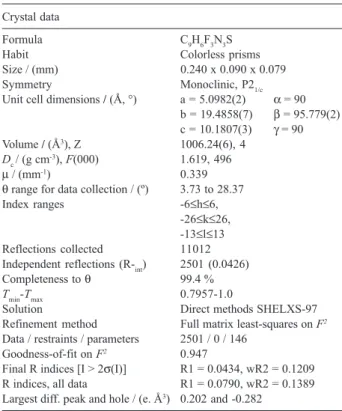
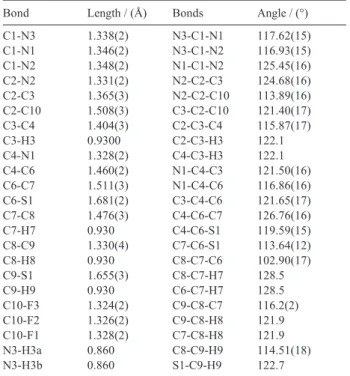
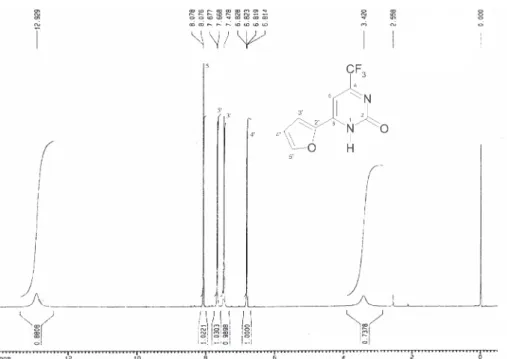
![Figure S2. 13 C[H] NMR spectrum of the 6-(2-furyl)-4-trifluoromethyl-1H-pyrimidin-2-one (2a), DMSO-d 6 .](https://thumb-eu.123doks.com/thumbv2/123dok_br/18991516.460813/8.892.178.684.102.459/figure-s-nmr-spectrum-furyl-trifluoromethyl-pyrimidin-dmso.webp)
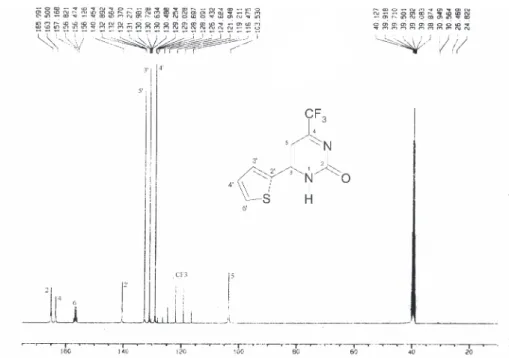
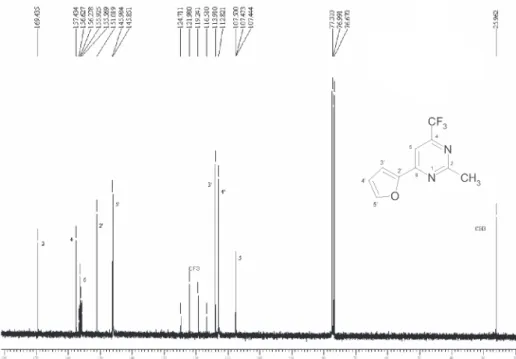
![Figure S8. 13 C[H] NMR spectrum of the 6-(2-thienyl)-2-methyl-4-trifluoromethylpyrimidine 3b, CDCl 3 .](https://thumb-eu.123doks.com/thumbv2/123dok_br/18991516.460813/11.892.204.715.101.451/figure-s-nmr-spectrum-thienyl-methyl-trifluoromethylpyrimidine-cdcl.webp)
